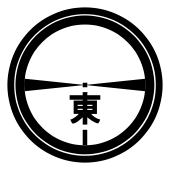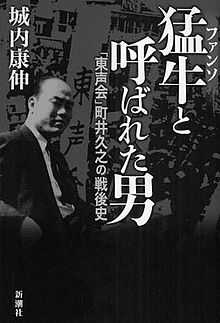Toa-kai

The Toa-kai (東亜会 Tōa-kai) is a yakuza syndicate based in Tokyo with a predominantly Korean Japanese membership. Originally named the Tosei-kai (東声会 Tōsei-kai, "Voice of the East Gang"[1]), with its historic leader Hisayuki Machii, the Toa-kai was deeply involved in the history of Tokyo's South Korean community and Japan's anti-communist circles in the 20th century. It is the fifth largest Yakuza clan.
History
The group was formed by Hisayuki Machii, a Korean Japanese mob boss,[2] as the Tosei-kai in 1948.[1] The Tosei-kai was originally a reported far-right organization of anti-communist activism[2] led by Machii as a sympathizer of Kanji Ishiwara,[3] which was in conflict with the North Korea-associated General Association of Korean Residents in Japan.[2]
The Tosei-kai quickly became one of Tokyo's most powerful gangs,[1] and had significantly expanded during the time of the post-war economic growth. Membership reached 1,500 in the 1960s.[2] As the leader of the syndicate, Machii became an essential "fixer" between Japan and South Korea.[4]
Increasing police crackdowns by 1965 forced Machii to disband the Tosei-kai and establish a new gang, the Toa Yuai Jigyo Kumiai (東亜友愛事業組合 Tōa Yūai Jigyō Kumiai), or "East Asia Friendship Enterprise Association". He also formed a "legitimate" company called the Toa Sogo Kigyo (東亜相互企業 Tōa Sōgo Kigyō), or East Asia Enterprises Company, with the famous Yoshio Kodama as Chairman of the Board.[5] Afterwards, the Toa Yuai Jigyo Kumiai changed the name as Toa Yuai (東亜友愛 Tōa Yūai) and Toa-kai.
The founder Machii retired in the 1980s,[4] and died of heart failure on September 14, 2002 in Tokyo. Also known as a successful businessman, he was 79.[6]
Condition
The Toa-kai is a member of a bakuto fraternal federation named the Kanto Hatsuka-kai, along with four other Kanto-based yakuza syndicates, the Sumiyoshi-kai, the Inagawa-kai, the Matsuba-kai, and the Soai-kai.[7] The Toa-kai has aligned itself with the largest known Yamaguchi-gumi syndicate since the syndicate's Taoka era in the 20th century,[2] and has been closely supported by Shinobu Tsukasa, the sixth-generation godfather of the Yamaguchi-gumi, since 2005 when the sixth era of the Yamaguchi-gumi officially started.[7]
Territories
The Toa-kai has its headquarters in Ginza, Tokyo ever since its formation.[8] The Toa-kai has its five branch organizations in Tokyo, and one branch organization outside of Tokyo.[9]
Okinawa
The Toa-kai's notable branch organizations include the Yoshimi-kogyo (誼興業).[10] The Yoshimi-kogyo is the Toa-kai's only branch organization based outside of Tokyo.[9] Based on the Okinawa island, the Yoshimi-kogyo is one of the three major yakuza groups in the Okinawa region, along with the Kyokuryu-kai and the Okinawa Kyokuryu-kai.[11]
The origin of the Yoshimi-kogyo reportedly traces back to the late 20th century, when Toshio Gibo, an ethnic Okinawan mobster, formed an anti-left nationalist organization named the Makoto-kai in Okinawa under influence of Yoshio Kodama. Gibo met with Machii through Kodama, founding an affiliate of the Tosei-kai in Okinawa.[3]
Okinawa's underworld has been known for its exclusiveness since the 20th century, where the dominating Kyokuryu-kai has persistently attacked and violently expelled any yakuza syndicate attempting to enter the island. The reason why the Toa-kai has been able to active on the island may be because the group has historically been more oriented to legitimate businesses, and of its gentle stance, in contrast to other yakuza syndicates which have attempted to expand their influences into Okinawa with heavy violence, such as the Yamaguchi-gumi and especially the Dojin-kai.
For example in 2002 in Okinawa, only one Yoshimi member was arrested, while 56 Kyokuryu-kai members and 95 Okinawa Kyokuryu-kai members were arrested.
Leadership

- Tosei-kai era
- President: Hisayuki Machii
- Toa Yuai Jigyo Kumiai era
- 1st president: Fujimatsu Hirano
- 2nd president: Morihiro Okita
- Toa Yuai era
- President: Shohei Futamura
- Toa-kai era
- 1st president: Shohei Futamura
- 2nd president: Yoshio Kaneumi
References
- ↑ 1.0 1.1 1.2 1.3 Yakuza: Japan's criminal underworld, p.228, 2003, David E. Kaplan and Alec Dubro, ISBN 0-520-21562-1
- ↑ 2.0 2.1 2.2 2.3 2.4 "Overview of a 'heretic' of post-war history", April 2009, The Facta Magazine (Japanese)
- ↑ 3.0 3.1 "Review : The Man Called the Wild Bull : 'Tosei-kai' Hisayuki Machii's Post-war History", March 2009, Shin'ichi Sano, Shinchosha (Japanese)
- ↑ 4.0 4.1 "Hisayuki Machii - Top 10 Real-Life Mob Bosses", 20 January 2011, TIME
- ↑ Yakuza: Japan's criminal underworld, p.229, 2003, David E. Kaplan and Alec Dubro, ISBN 0-520-21562-1
- ↑ "Mr. Hisayuki Machii passes away", 21 September 2002, 47 News, Kyodo (Japanese)
- ↑ 7.0 7.1 "The Yamaguchi-gumi Bakuhu theory", Kenji Ino, 17 December 2007 (Japanese)
- ↑ "The Man Called the Wild Bull : 'Tosei-kai' Hisayuki Machii's Post-war History", 18 February 2009, Yasunobu Shirouchi, ISBN 978-4-10-313731-3 (Japanese)
- ↑ 9.0 9.1 "Toa-kai", Yakuza Wiki (Japanese)
- ↑ "Boryokudan Expulsion Manual", July 2011, Okinawa Prefectural Police (Japanese)
- ↑ "Boryokudan condition in the prefecture", October 2007, Okinawa Prefectural Conference for the Expulsion of the Boryokudan (Japanese)